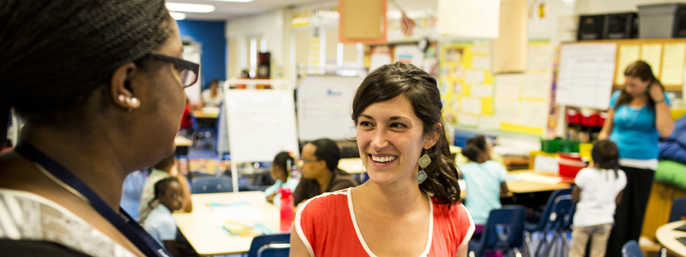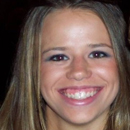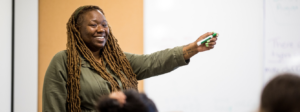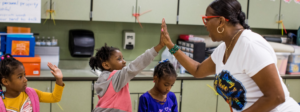Victoria Lautsch is the Director of Recruitment at UP Education Network, a nonprofit that has turned around five underperforming district schools in Massachusetts. Last year, two UP schools took part in our Insight survey that measures teacher perceptions of school culture. Their results contributed to our recent report, Greenhouse Schools in Boston: School Leadership Practices Across a High-Performing Charter Sector. We heard anecdotally that UP was doing a particularly good job with hiring a diverse team of teachers, so we sat down with Vicki to learn more about their approach.
What are some qualities you look for in UP teaching candidates?
We’re looking for teachers with the drive and passion to do what it takes for their students to succeed on the path to college. Turning around a school is hard. We want educators who embrace challenges and are prepared to be a team player to meet the needs of our kids. Someone who sees that 80 percent of their students have mastered a lesson and immediately thinks, “That’s great, but how do I get the other 20 percent to master it, too?”
We’re also looking for teachers who understand the value of connecting with the communities where we work. We want teachers who value family engagement; teachers who want to share and celebrate their students’ success and accomplishments; and teachers who really understand their students, their families and the communities we work in. It’s worth noting that there is no “one size fits all” teacher. People take different paths that lead them to education, and simply put, we seek those who can contribute to our scholars’ growth.
We know UP is particularly committed to building a diverse and inclusive teaching staff. What kind of diversity are you looking for in incoming teachers?
We think of—and approach—diversity and inclusivity in a number of ways.
Cultural and racial diversity is of course important. Having a diverse group of teachers who look like our students allows our students to see themselves in their teachers and their community at-large.
We’re also committed to ensuring we have a linguistically diverse staff. When we inherit schools, we inherit a lot of English language learning programs, too. It’s important to connect with all of our scholars, and being able to speak the language of our scholars and their families is key.
Gender diversity is also key, and we work hard to attract male teachers, particularly men of color who are interested in teaching at the elementary school level. Nationwide there is a scarcity of male instructors in early childhood settings. There’s a lot of research that says it’s important for young elementary students (boys and girls) to see males as teachers and mentors.
It is important to keep in mind that we are always looking to improve our efforts to create a more diverse and inclusive environment. We know our Insight survey results indicate we approach hiring a little differently than other schools, and that we’re doing well. Nonetheless, we are not yet where we want to be and diversity and inclusivity will remain a top priority for our team.
What strategies do you use to build a diverse pool of incoming candidates?
We do a lot of recruiting through community-based organizations, in addition to traditional spaces like schools and universities. For instance, at UP Academy Holland in Boston, we inherited a language program for Vietnamese-speaking students. We sought qualified teaching candidates from within the existing program and at a nearby Vietnamese cultural center. By meeting with the staff at the center, advertising in their newsletter, and volunteering with their organization, we developed relationships that helped us find potential UP staff members. In grades one through five at UP Academy Holland, 49 percent of our staff members identify as a person of color and 39 percent speak a second language.
In Lawrence, Massachusetts, many recent graduates are returning home from college and want to revitalize their city; we’ve made an effort to tap into that energy. Two of our current staff members on the recruitment team are from Lawrence, went to high schools there, and returned for the same reasons as these potential candidates. Our recruiters are able to connect our mission to their goals. We encourage current staff members to engage with professional groups, colleagues and friends. These networks help provide a great source of potential candidates.
How do you think teachers benefit from being a part of such a diverse teaching staff?
I think when you are in a workplace that is more diverse and inclusive, you feel more comfortable expressing different opinions. You also learn from the people around you, and from how differently they may approach problem-solving. This is especially helpful for our teachers as they grow as professionals and work together to meet the varying needs of our students. It’s exciting to know that our teachers have the opportunity to learn just as much as our students.
It’s also really helpful to be around such diversity during a time in which a lot of societal issues pertaining to race and culture have been pushed to the forefront. Having an inclusive environment allows us to address the tough questions and concerns from our students and staff that follow events—like the tragedy in Ferguson—in productive and positive ways.
How do you assess whether or not incoming candidates will welcome such an open culture?
We have a multi-phase interview process, and when a candidate progresses to the stage where they interview with specific school-based leaders, we incorporate questions into our conversations related to culture and inclusivity. For example, we make sure school leaders ask specific questions related to cultural competence based upon the school and its location. That said, there’s a lot of autonomy given to each school’s hiring manager because at the end of the day, school leaders can better gauge a school’s dynamic.
Before we extend any offers, I also have weekly meetings with every school and hiring team to ensure we’ve asked the hard questions about each candidate and that we are all comfortable that he or she understands how they can add value to our schools and our communities.
What are some big challenges you run into when recruiting new teachers?
One of the biggest challenges for us is hiring effectively on such a large scale. When we restart an underperforming school, we typically have to onboard an entirely new teaching staff (although teachers at the previous school are encouraged to apply for a position with UP). What this means is that as our network grows, we have to hire more and more full teaching staffs. It’s already very hard to find quality candidates who want to do the tough work of school turnaround—staffing an entire school is a huge challenge.
Another big challenge is not just hiring staff, but also developing and retaining them. We want our strongest staff members to view their school and community as somewhere they want to stick with for the long haul. Making sure our staff members feel supported and invested in is extremely important.








